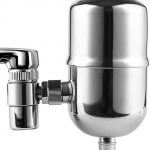According to a study published in the Lancet, in 2015, water contamination killed 1.8 billion people throughout the world.
The quality of water has changed since then, but contaminated water still sickens about 1 billion people every year.
You may be tempted to think that this might be a problem for developing countries. Unfortunately, you are mistaken, because even if you’re sitting in the USA, sipping on a crystal clear glass of water, thanks to exemplary water treatment facilities, potentially harmful contaminants such as arsenic or bacteria may still be finding their way into your drinking water, gradually taking their toll on your health.
Removal of Water Contaminants
Now that we have an idea about some common contaminants, let’s briefly talk about how we can remove them to improve the quality of our water.
Test Your Water
As the elders say, to fight an enemy you need to understand your enemy. Similarly, you need to know what contaminants are polluting your water to eliminate them!
For this, you can either take a sample from your water and get it checked from any government or private water testing facilities, or you can cut the hassle and cost and get yourself a water testing kit. You can use it in a few simple steps to keep your water quality in check without going back and forth to water testing labs each month!
Do you want to figure out which one suits you? Check our reviews over the best water testing kits available.
Filter Your Water
Depending on how much and how many types of contaminants are present in your water, you can go from a simple faucet water filter to a more advanced reverse osmosis filter, or a whole house water filter.
Top Faucet Water Filter Reviewed:
Check out the comparison between different water filters and find a filter suitable for your needs.
For microorganisms, you may additionally want to get yourself chlorinated water (has harmful effects in the long run), or better an Ultra-Violet water filter, which cleanses your water from microorganisms, and is easily adjustable with your chosen water filtration system.
For just hard water, check out the reviews on the best water softeners available currently in the market.

What are Water Contaminants?
Water contaminants simply mean extra substances that are present inside your water, often possessing harmful effects on your health. These contaminants, at elevated levels, may cause harmful acute diseases such as gastrointestinal Illness to gradual harmful effects such as kidney problems, mental disorders, endocrine abnormalities, and even cancer.
The common contaminants that we should be aware of can be categorized into:
- Lethal contaminants: They cause treatable illnesses to life-threatening conditions.
- Damaging contaminants: They alter water quality, cause staining and discoloration of gums and skin.
- Emerging contaminants: Currently, they are present in a scarce amount but have the potential to be as harmful as primary water contaminants in the future.
Here is the list of some common contaminants based on the earlier types:
Lethal Contaminants
Biological Primary Water Contaminants
They include microorganisms such as:
Giardia
In the United States, Giardia infection is the most common intestinal parasitic disease affecting humans and nearly 33% of people in developing countries have had giardiasis. Symptoms include diarrhea, cramps, nausea.
Cryptosporidium
It causes watery diarrhea, stomach cramps or pain, dehydration, nausea, vomiting, and fever. Through water, this bad guy has been involved in causing outbreaks numerous times.
E. coli
There are an estimated 79,420 cases of ETEC in the United States each year and the symptoms include watery or bloody diarrhea, abdominal cramps, with or without fever.
Salmonella
Commonly causing Typhoid, this bacterium results in about 1.35 million infections, 26,500 hospitalizations, and 420 deaths in the United States every year.
Vibrio Cholera
This bacterium has killed millions of people across the world through pandemics and epidemics. The disease is characterized by acute and very intense diarrhea that can exceed one liter per hour.
Viruses
According to WHO, viruses such as adenovirus, astrovirus, hepatitis A and E viruses, rotavirus spread through water.
These viruses can cause diseases such as enteritis, and diarrhea. Some of these viruses are extremely harmful, for example, rotavirus is the leading cause of severe acute diarrhea in children under the age of five globally, resulting in over half a million deaths annually.
Non-Biological Primary Water Contaminants
Inorganic Compounds
Arsenic: Causes cancer, heart-related, brain-related and GI problems
Chromium: Causes cancer
Copper: GI issues, Liver and kidney problems
Chlorine and Chloramine: Eye and nose irritation, and stomach discomfort
Fluoride: Bone issues
Lead: Developmental issues in children, skin problems, and mental issues
Mercury: Has negative effects on the skin, brain functions, vision, and hearing
Nitrate/Nitrite: Mostly harmful to infants; causes cyanosis, and respiratory problems
Organic compounds
Agricultural Chemicals: Currently, it is one of the largest sources of water pollution. The application of chemical fertilizers, the collection of animal manure, and the use of chemicals used by farmers result in nitrogen and phosphorus. These are not only harmful to our health but also result in eutrophication, which is the degradation of the aquatic environment.
Industrial Chemicals: Nowadays, industrial pollution of water is majorly caused by manufacturing plants. According to EPA, power plants are the largest contributors to industrial water pollution. These are sources for toxic substances like mercury, arsenic, and lead. According to EPA, water pollution from industrial facilities is responsible for polluting water quality in more than 10,000 miles of rivers and more than 200,000 acres of lakes, ponds, and estuaries nationwide.

Damaging contaminants
These include:
Aluminum: Causes bluish discoloration of gums and mouth.
Iron: Changes the taste of water, clogs water pipes, and aids in the growth of some extremely harmful bacteria.
Manganese: Changes the taste and smell of water, which can cause staining.
Sulfur: Changes the taste and smell of water; can corrode pipes if converted to hydrogen sulfide.
Calcium and Magnesium (Hardness)
These elements cause the water to become “hard”. This is not only harmful to drinking and cooking but also clogs your water pipes, and shortens the lifespan of your home appliances such as dishwashers, washing machines, cooking appliances, etc.
Emerging contaminants
These include the following pollutants:
Drugs and Medications:
Items such as drugs and medications, which when expired, get dumped or flushed into water. For now, their amount is not enough to cause any harmful effects, but in the future, they may cause some serious toxicities.
Other Substances:
These may include personal care products such as antibiotic soaps, perfumed products, man-made chemicals, such as PFAS, which are found in food, packaging, and household products.
In conclusion, drink healthy, stay healthy!
Water is life; therefore, you should keep it pure and fresh to the utmost of your capability to avoid life-threatening diseases. A few bucks spent on water filters may save you from spending a massive chunk on home appliances, and on hospitals, while keeping you fresh, fit, and healthy.



